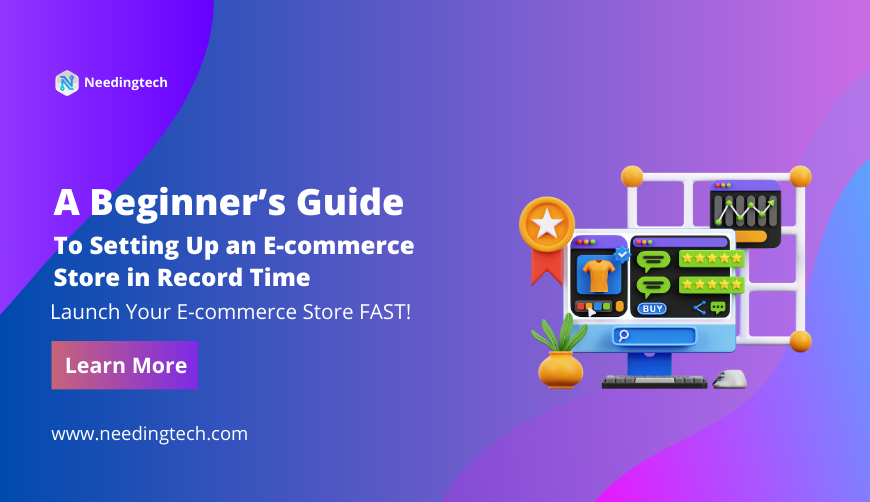A Beginner’s Guide to Setting Up an E-commerce Store in Record Time
Starting an e-commerce store has never been easier. With the right approach, you can launch your online shop in record time and start selling products globally. Whether you’re a budding entrepreneur or an established business looking to expand online, this guide will walk you through the key steps to get your store up and running efficiently.
At NeedingTech, we specialize in e-commerce website development, ensuring you get a professional, high-performing online store tailored to your business needs. Our custom e-commerce solutions are designed to help businesses like yours thrive in the competitive online marketplace.
- Choose Your Niche and Products
Selecting the right e-commerce niche is crucial for success. Research trending products, analyze competition, and find a profitable market. Tools like Google Trends, Amazon Best Sellers, and Shopify Trends can help you identify what’s in demand. Ensure you choose products that align with your expertise and target audience’s needs.
Pro Tip : Focus on high-demand, low-competition products to maximize your chances of success.
- Pick the Right E-commerce Platform
Choosing the right e-commerce platform can make or break your store. Popular options include:
-
Shopify A user-friendly platform with built-in features and quick setup.
WooCommerce A great choice for WordPress users looking for flexibility.
Magento Ideal for large-scale businesses needing advanced customization.
BigCommerce Suitable for fast-growing brands with robust sales features.
Each platform has its own strengths, so choose the one that best suits your business model.
Not sure which platform is right for you? Our e-commerce experts can guide you.
-
-
Register a Domain and Set Up Hosting
Your domain name is your brand identity, so pick something memorable and relevant to your niche. Use platforms like GoDaddy, Namecheap, or Google Domains to secure your domain. If you’re using WooCommerce, you’ll also need reliable hosting like SiteGround, Bluehost, or Hostinger.
Need help setting up your domain and hosting? Check out our services for expert assistance.
-
Design Your Online Store
A well-designed website enhances user experience (UX) and boosts conversions. Most e-commerce platforms offer pre-built themes, but you can customize them to align with your brand. Key elements include:
-
Clear navigation - Ensure easy access to products and categories.
-
High-quality images - Showcase products with professional photos.
-
Mobile responsiveness - Optimize for mobile shoppers.
-
Fast loading speed - Use tools like Google PageSpeed Insights to optimize performance.
Looking for a custom e-commerce design that stands out? Our experts can help.
-
-
Add Essential Pages and Features
To build trust with your customers, include these key pages:
-
Homepage - A compelling introduction to your store.
-
Product pages - Detailed descriptions, pricing, and high-quality images.
-
About Us - Share your brand story.
-
Contact Us - Provide multiple ways for customers to reach you.
-
Shipping & Returns Policy - Build transparency with clear policies.
Additionally, integrate essential features like a shopping cart, secure payment gateways (PayPal, Stripe, Razorpay), and a customer support chat.
Need help integrating secure payment gateways? Learn more.
-
-
Optimize for SEO and Marketing
Search engine optimization (SEO) is key to attracting organic traffic. Implement on-page SEO tactics like:
Using keyword-rich product descriptions
Optimizing images with alt text
Writing SEO-friendly blog posts
Securing backlinks from authoritative sites (such as industry blogs and directories)
For faster results, consider running Google Ads, Facebook Ads, and Instagram marketing campaigns. Email marketing tools like Mailchimp can also help nurture leads and drive conversions.
Want to boost your store’s visibility? Explore our SEO and marketing services.
-
Launch and Start Selling
Before launching, test your site for any errors. Check for broken links, ensure your checkout process is seamless, and test on different devices. Once everything looks good, promote your launch through social media, influencer collaborations, and PPC ads.
Need expert guidance on launching your store? Get in touch with us.
Conclusion
Setting up an e-commerce store doesn’t have to be complicated or time-consuming. With the right tools and strategy, you can launch your store quickly and efficiently. Ready to get started? Explore our e-commerce development services for expert assistance in launching your store today!
At NeedingTechwe provide custom e-commerce website development, payment gateway integration, and SEO services to help businesses succeed online. Let us handle the technical aspects while you focus on growing your brand.

